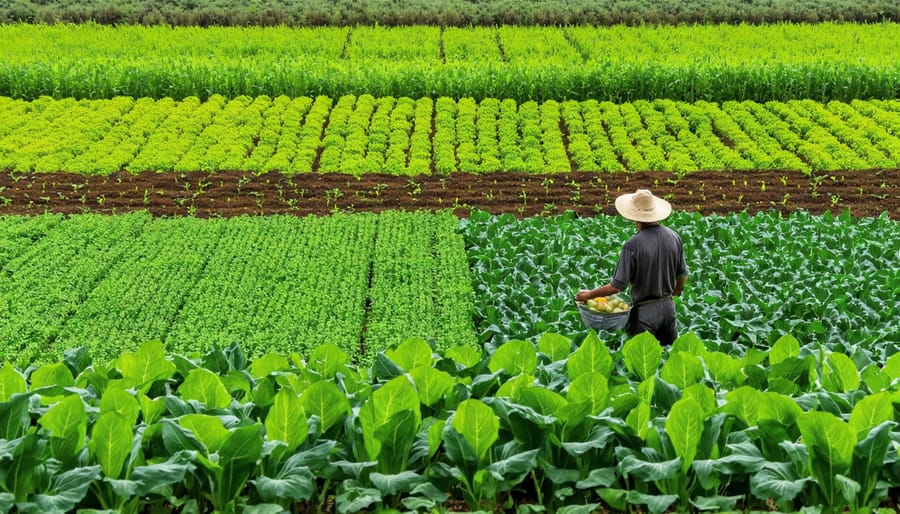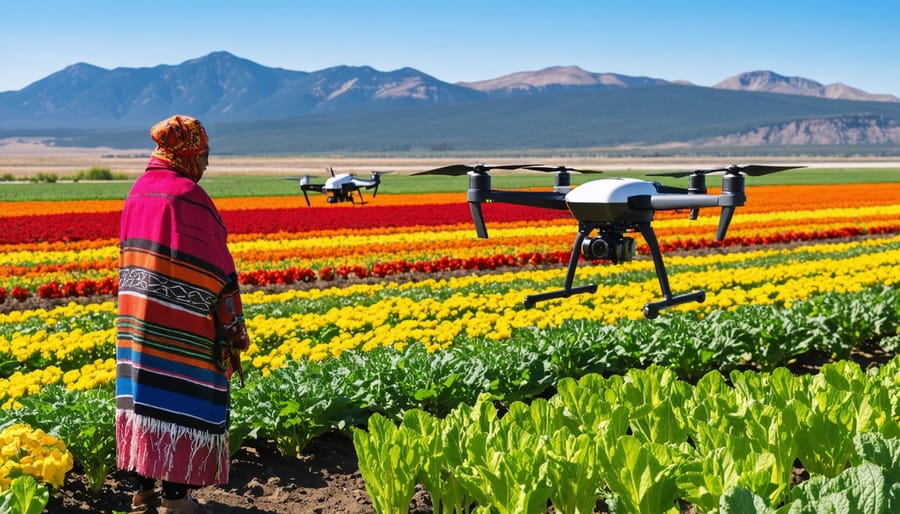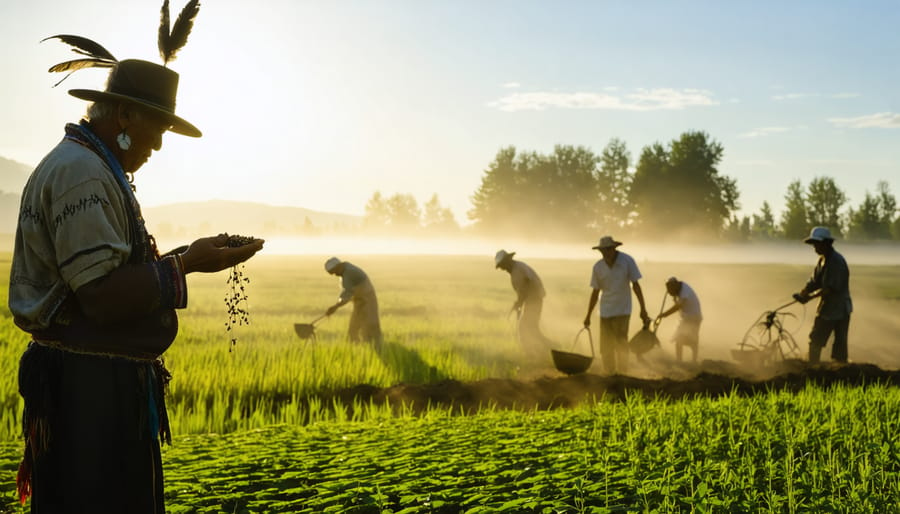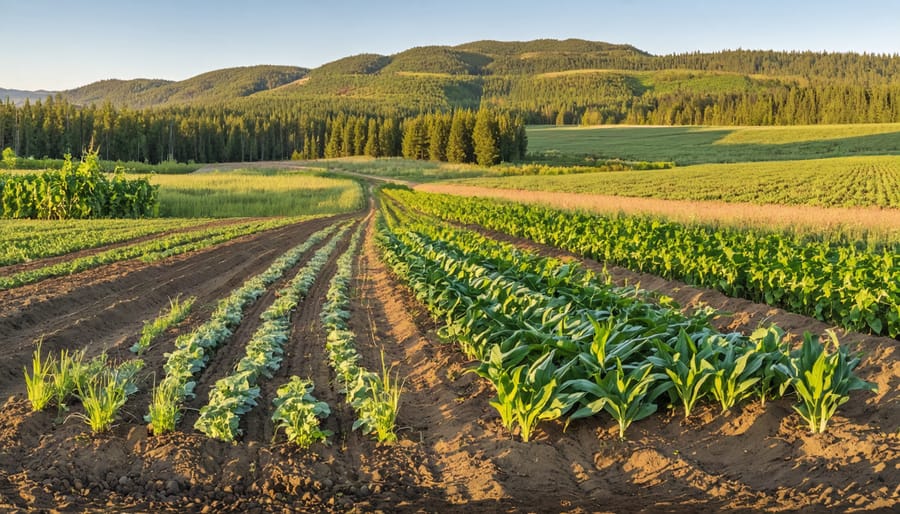Transform your farm’s resilience and profitability by implementing strategic crop diversification across your available acreage. Plant complementary crops that mature at different times throughout the growing season, following time-tested indigenous permaculture principles that have sustained Canadian agriculture for generations. Research shows Alberta farms practicing diversification experience up to 40% greater soil fertility and 30% reduced pest pressure compared to monoculture operations.
Modern diversification combines traditional wisdom with cutting-edge agricultural science, creating resilient farming systems that protect against market volatility and climate uncertainties. By integrating different crop families – from nitrogen-fixing legumes to deep-rooted cereals – farmers build natural soil fertility while spreading their economic risk across multiple revenue streams. This practical approach to agriculture not only enhances biodiversity and soil health but also provides steady income throughout the growing season, making it an essential strategy for forward-thinking Canadian farmers.
The key to successful diversification lies in selecting crops that align with your local climate, available equipment, and market opportunities while maintaining manageable operational complexity. Whether you’re managing 100 hectares or 1000, thoughtful crop diversity creates a more sustainable and profitable farming operation.
Traditional Indigenous Farming Wisdom in Alberta
Three Sisters and Beyond
The Three Sisters farming method, developed by Indigenous peoples across North America, remains one of the most effective examples of companion planting. This traditional practice combines corn, climbing beans, and squash in a mutually beneficial relationship. The corn provides a natural trellis for beans, while beans fix nitrogen in the soil, and squash’s broad leaves suppress weeds and retain moisture.
Modern Alberta farmers are adapting this ancestral wisdom to suit contemporary needs. For instance, the Mackenzie family farm near Lethbridge successfully incorporates Three Sisters principles in their 400-hectare operation by planting sweet corn with pole beans and pumpkins in dedicated sections, reporting improved soil health and reduced input costs.
Beyond the traditional trio, innovative farmers are creating new companion combinations. Popular pairings include canola with field peas, barley with clover, and wheat with alfalfa. These modern adaptations maintain the core benefits of companion planting while accommodating mechanized farming methods and market demands. Research at Alberta’s agricultural institutes shows these diversified planting systems can increase yields by 15-20% while enhancing natural pest resistance.
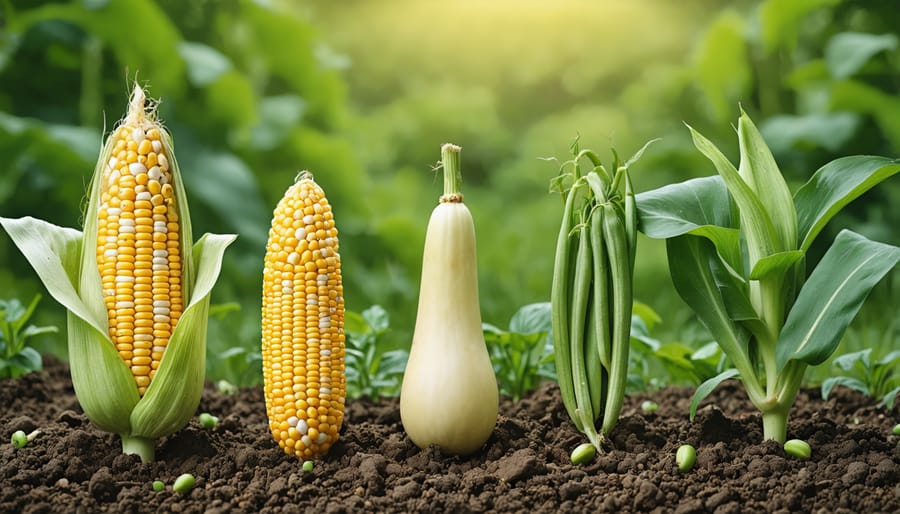
Seasonal Crop Selection
Indigenous communities in Alberta have long understood the rhythm of seasonal planting, developing sophisticated crop selection methods that modern farmers can learn from today. These practices, coupled with traditional water management practices, offer valuable insights for optimal crop timing in our region’s unique climate.
For spring planting (April-May), early-season crops like field peas and early barley varieties thrive in Alberta’s cool soil conditions. Summer crops (June-July) traditionally include heat-loving plants such as canola and wheat, while fall planting windows (August-September) are ideal for winter wheat and fall rye.
Indigenous wisdom teaches us to observe natural indicators: when saskatoon bushes bloom, it’s time to plant warm-season crops; when golden rod flowers, it signals the final planting window. This knowledge, combined with modern weather forecasting, helps farmers make informed decisions about crop timing.
For success in Alberta’s climate, consider rotating through these seasonal windows with complementary crops that support soil health and maximize growing days. Many local farmers find success by incorporating both indigenous timing knowledge and contemporary crop varieties.
Modern Benefits of Traditional Diversification
Soil Health Enhancement
Implementing crop diversification is one of the most effective sustainable farming methods for enhancing soil health across Alberta’s varied landscapes. When different crops are rotated through fields, each plant species contributes unique benefits to soil structure and nutrient composition.
Deep-rooted crops like alfalfa and canola create natural channels for water infiltration and aeration, while their extensive root systems help break up compacted soil layers. Pulse crops, such as peas and lentils, form beneficial relationships with soil bacteria that fix nitrogen naturally, reducing the need for synthetic fertilizers.
The varying root depths of different crops access nutrients at different soil levels, preventing nutrient depletion in any single layer. This creates a more balanced soil profile over time. Additionally, crop diversity increases organic matter content through varied plant residues, improving soil structure and water-holding capacity.
Research from Alberta Agriculture shows that fields under diverse rotation systems typically demonstrate 15-25% higher organic matter content compared to monoculture fields. This translates to better soil aggregation, increased microbial activity, and improved nutrient cycling.
The combination of different crop types also helps manage soil-borne diseases and pests naturally, as harmful organisms can’t easily establish themselves when their preferred host plants aren’t continuously present in the same location.

Natural Pest Management
Natural pest management through crop diversity is a time-tested practice that many Alberta farmers have successfully implemented in their operations. By strategically planting different crop varieties together, you create natural barriers that confuse and deter pests, reducing the need for chemical interventions.
Companion planting is particularly effective in our prairie climate. For instance, planting aromatic herbs like dill and cilantro alongside brassicas helps repel cabbage moths, while marigolds naturally ward off harmful nematodes. Many local farmers have found success with the traditional “Three Sisters” method – planting corn, beans, and squash together – which not only manages pests but also improves soil health.
Strip cropping, where different crops are planted in alternating strips across a field, creates natural corridors that beneficial insects can use to patrol your crops. This method has shown impressive results in controlling wheat stem sawfly, a common pest in Alberta wheat fields.
Trap cropping is another effective strategy where sacrificial plants attract pests away from your main crop. Local farmers often plant canola or mustard around the perimeter of their main fields to draw away flea beetles and other harmful insects.
Remember to rotate your crops annually, as this breaks pest life cycles and prevents populations from establishing themselves in your fields. This traditional wisdom, combined with modern farming practices, offers a sustainable approach to pest management that many Alberta farmers have successfully adopted.
Implementing Traditional Diversification Today
Planning Your Rotation
Building on traditional farming wisdom, planning your crop rotation requires careful consideration of several key factors. Start by mapping your available land and dividing it into manageable sections. Consider creating a detailed soil analysis for each section to understand nutrient levels and soil health.
Next, list your desired crops and group them by family. For Alberta farmers, common groupings include cereals (wheat, barley), legumes (field peas, faba beans), oilseeds (canola, flax), and root crops (potatoes, sugar beets). Consider each crop’s growing season, water requirements, and nutrient needs.
Create a four to five-year rotation plan, ensuring that crops from the same family don’t follow each other. A typical Alberta rotation might look like:
Year 1: Cereals
Year 2: Legumes
Year 3: Oilseeds
Year 4: Different cereals or cover crops
Factor in market demands and your farm’s capabilities. Keep detailed records of each field’s history, including yields, pest issues, and weather impacts. This information becomes invaluable for future planning.
Remember to include disease-suppressive crops like mustard or specific cover crops between main rotations. Leave room for flexibility – weather patterns and market conditions may require adjustments to your plan. Consider consulting with local agricultural extension services for region-specific advice and timing recommendations.
Companion Planting Strategies
Alberta’s unique growing conditions offer excellent opportunities for strategic companion planting. Based on local farming experience and research from the University of Alberta, several plant combinations have proven particularly successful in our climate.
Legumes like field peas and faba beans work exceptionally well when planted alongside cereals such as wheat or barley. The legumes fix nitrogen in the soil, benefiting their companion crops while improving overall soil health. This combination typically yields 15-20% more than single-crop plantings in Alberta conditions.
Root vegetables like carrots partner effectively with onions and leeks, as the strong scents help deter pest insects. Canola farmers have found success incorporating strips of aromatic herbs like dill and cilantro, which attract beneficial insects while supporting pollination.
For market gardeners, the “Three Sisters” method – planting corn, climbing beans, and squash together – has proven successful even in our shorter growing season. The corn provides support for the beans, while the squash leaves create ground cover that retains moisture and suppresses weeds.
Cool-season crops like cabbage family plants thrive when interplanted with aromatic herbs such as sage and thyme, which help mask their scent from common pests. Many Alberta farmers report reduced pest problems and improved yields using these combinations.
Remember to consider your specific microclimate and soil conditions when selecting companion planting combinations, as results can vary across different regions of the province.
Overcoming Common Challenges
Implementing crop diversification can present several challenges, but Alberta farmers have developed effective strategies to overcome them. One common hurdle is the initial investment in new equipment and seeds. Many farmers address this by starting small, perhaps dedicating 10-15% of their land to new crops, and gradually expanding as they build confidence and resources.
Market access can also be challenging when introducing new crops. Successful farmers often tackle this by researching market opportunities before planting and forming partnerships with local food processors or joining agricultural cooperatives. Some have found success through direct-to-consumer sales at farmers’ markets or through community-supported agriculture programs.
Learning new farming techniques is another significant challenge. The Alberta Agriculture and Forestry department offers workshops and mentorship programs to help farmers master new crop management practices. Many experienced farmers also recommend connecting with other growers who have successfully diversified their operations.
Managing different harvest times and storage requirements can strain resources. Creating detailed scheduling plans and investing in adaptable storage solutions has helped many farmers navigate this challenge. Some farmers share equipment or storage facilities with neighbours to reduce costs.
Weather uncertainty remains a constant concern, but diversification itself helps mitigate this risk. By growing crops with different climate tolerances and maturation periods, farmers create natural insurance against weather-related losses. Incorporating drought-resistant varieties and using irrigation systems strategically has proven effective for many Alberta farmers.
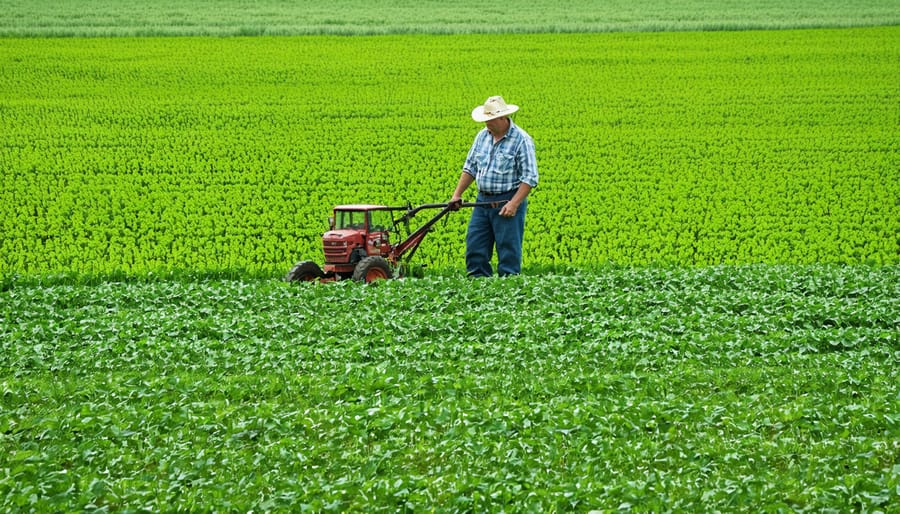
Success Stories from Alberta Farms
The success of crop diversification in Alberta is best illustrated through the experiences of farmers who’ve embraced these practices. Take Sarah and Jim Morrison from Lacombe County, who transformed their 800-hectare wheat monoculture into a thriving mixed-crop operation. Over five years, they integrated pulses, canola, and barley into their rotation, resulting in a 30% increase in soil organic matter and a 25% reduction in fertilizer costs.
Near Medicine Hat, third-generation farmer David Thompson discovered that adding mustard and chickpeas to his traditional wheat rotation helped break disease cycles and improved his farm’s resilience during drought years. “When wheat prices dropped in 2019, our diverse crop portfolio kept us profitable,” Thompson explains. His strategic approach to diversification has led to a more stable income stream and reduced his reliance on crop insurance.
The Blackfoot First Nation’s collaborative farming project near Lethbridge demonstrates how traditional knowledge can enhance modern diversification practices. Working with local farmers, they’ve successfully integrated ancient Three Sisters companion planting principles into commercial-scale operations. This partnership has resulted in improved soil health and reduced pest pressure across 400 hectares of farmland.
In the Peace River region, Maria Rodriguez has become known for her innovative approach to crop rotation. By incorporating fava beans and hemp into her existing canola and wheat operation, she’s created new market opportunities while improving her soil structure. “Our earthworm population has doubled since we started diversifying,” Rodriguez notes, “and we’re seeing better water retention throughout the growing season.”
The Kumar family farm near Red Deer presents another compelling success story. After switching from a two-crop system to a six-crop rotation including quinoa, lentils, and flax, they’ve reported a 40% reduction in pesticide use and established valuable direct-marketing relationships with local food processors.
These success stories share common themes: improved soil health, better risk management, and enhanced economic stability. While the transition to diversified cropping systems required careful planning and some initial investment, these Alberta farmers demonstrate that the long-term benefits make it a worthwhile endeavor. Their experiences provide practical blueprints for other farmers considering similar transitions in their operations.
Crop diversification represents a powerful strategy for building resilient and sustainable farming operations across Alberta. By incorporating multiple crop varieties into your rotation, you’re not just protecting against market fluctuations and weather uncertainties – you’re investing in the long-term health of your soil and the stability of your farm business. The success stories we’ve seen across the province, from small family farms to large agricultural operations, demonstrate that diversification is both practical and profitable in our unique climate.
Remember, starting small and gradually expanding your crop portfolio is often the most sustainable approach. Connect with local agricultural extension services, join farmer networks, and consider partnering with experienced producers who’ve already embraced diversification. Every step toward a more diverse farming system strengthens not just your operation, but our entire agricultural community. The future of Canadian farming lies in adaptability and innovation – and crop diversification is your pathway to achieving both.

